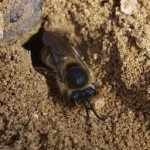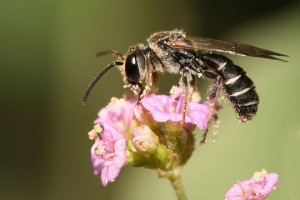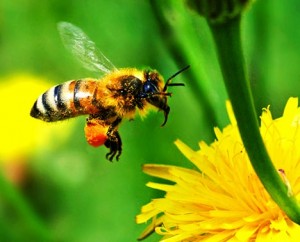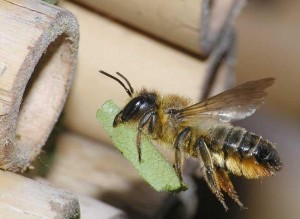 Most people when they think of bees think of honey and bumble bees and of socially complex colonies. However more than 85% of the 20,000 plus species of bees in the world are actually ‘solitary’, that is, there is no structured social system of workers and queens, rather each female bee builds her own nest, provides nectar and pollen in each cell for her larvae to eat, lays eggs in these cells and then seals the nest and departs; typically dying herself before her offspring emerge. Occasionally nest sites are built near others of the same species for protection and to ensure the likelihood of successfully mating of the next generation.
Most people when they think of bees think of honey and bumble bees and of socially complex colonies. However more than 85% of the 20,000 plus species of bees in the world are actually ‘solitary’, that is, there is no structured social system of workers and queens, rather each female bee builds her own nest, provides nectar and pollen in each cell for her larvae to eat, lays eggs in these cells and then seals the nest and departs; typically dying herself before her offspring emerge. Occasionally nest sites are built near others of the same species for protection and to ensure the likelihood of successfully mating of the next generation.
The usual pattern for solitary bees is to emerge from their nests as adults, quickly groom themselves and set out to find food. Male solitary bees usually emerge earlier than female solitary bees and often position themselves near floral resources, waiting to encounter receptive females. Thereby ensuring that reproduction occurs as quickly and efficiently as possible. Male bees die shortly after mating and then the fertilised female bees go in search of a nest site.
There are two main types of solitary bees nests, ground nests and cavity nests. Ground nesting solitary bees, such as sweat bees (Halictids) and alkali bees (Andrenids) will dig out a subterranean nest in loose, sandy substrate. Cavity nesters such as leaf cutter bees and orchard bees (Osmia) will look for suitably sized pre-existing cavities such as hollow stems or holes in wood and walls.
Once the nest is either excavated or a suitable cavity is found, the female bee constructs a series of cells, each of which will house a food source, usually a mix of pollen and nectar packed into a ball to house a single egg. Depending on the species, she will line the walls of the nest with leaves, petals, mud or bodily secretions to create the cell. Once provisioned and containing an egg she then seals off this individual cell and proceeds to build another.
In this way the female bee constructs a series of individual cells that each contain one egg and a food source. It can take anywhere from 20 to 30 trips to line the cell and provision food. It is on these trips to collect pollen and nectar for her nest that the female solitary bee acts as a pollinator for wild plants and food crops. Solitary bees are important pollinators and some species such as mason and leaf cutter bees are being increasingly cultured for commercial pollination.
The eggs are left to hatch and develop without any parental care. When they hatch, the tiny larvae eat the food that the female provisioned. Larvae grow and moult and eventually reach the pupal stage where they transform into an adult bee. When it is time for the adults to emerge, they chew their way out of the of the cell and exit the nest.
The number of generations that a species of solitary bee will have during a year can vary from just one to two or three, depending on the species. When a bee has a single generation in a year, the larvae or pupae will overwinter in the nest and will emerge the following year as an adult. In species that have multiple generations per year, the first generation will emerge into adults who will mate, forage and build a nest and the final generation of the season will overwinter as either larvae or pupae.



